
This article deals with available tools that offer solutions and could help you become more efficient and productive.
- Subject:
- Management
- Material Type:
- Reading
- Author:
- Ana-Maria Sanders
- Date Added:
- 03/03/2020

This article deals with available tools that offer solutions and could help you become more efficient and productive.

Marketing and project management should always go hand in hand. If you are thinking of different ways to market your products and services, you also need to find methods to improve your marketing project management. Here are simple ways to help improve your marketing project management.
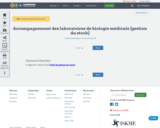
Il s’agit d’un fichier Excel (Outil de gestion du stock)

This course introduces interactive oral and interpersonal communication skills critical to leaders, including strategies for presenting to a hostile audience, running effective and productive meetings, active listening, and contributing to group decision-making. There are team-run classes on chosen communication topics, and an individual analysis of leadership qualities and characteristics. Students deliver an oral presentation and an executive summary, both aimed at a business audience.

This course draws on a wide range of perspectives to explore the roots of long term competitive advantage in unusually successful firms. Using a combination of cases, simulations, readings and, most importantly, lively discussion, the course will explore the ways in which long term advantage is built from first mover advantage, increasing returns, and unique organizational competencies. We will focus particularly on the ways in which the actions of senior management build competitive advantage over time, and on the strategic implications of understanding the roots of a firm's success.

Description: Advertising Management is a planned managerial process designed to oversee and control the various advertising activities – Here we are going to see an introduction, scope, feature and appeals of advertising, in brief.Learning outcome: After learning this content, learner can understand the concepts of feature elements, colour scheme, appeal applied in an advertisement

This course meets weekly to discuss recent aerospace history and current events, in order to understand how they are responsible for the state of the aerospace industry. With invited subject matter experts participating in nearly every session, students have an opportunity to hone their insight through truly informed discussion. The aim of the course is to prepare junior and senior level students for their first industry experiences.

This course addresses the architecting of air transportation systems. The focus is on the conceptual phase of product definition, including technical, economic, market, environmental, regulatory, legal, manufacturing, and societal factors. It centers on a realistic system case study and includes a number of lectures from industry and government. Past examples include: the Very Large Transport Aircraft, a Supersonic Business Jet, and a Next Generation Cargo System. The course identifies the critical system level issues and analyzes them in depth via student team projects and individual assignments. The overall goal of the semester is to produce a business plan and a system specifications document that can be used to assess candidate systems.

This course provides an overview of airline management decision processes with a focus on economic issues and their relationship to operations planning models and decision support tools. It emphasizes the application of economic models of demand, pricing, costs, and supply to airline markets and networks, and it examines industry practice and emerging methods for fleet planning, route network design, scheduling, pricing and revenue management.
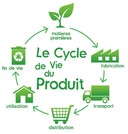
Ce document détaille la démarche de l’analyse ACV.la lecture de ce document permet de découvrir les domaines d’application de la méthode ACV et d'appréhender les avantages et les inconvénients de l’analyse.A la fin de la lecture, l'apprenant sera capable de Maitriser les outils d’analyse des impacts.

Ce cours traite des éléments liés au milieu physique et plus précisément l'espace physique rural et les méthodes utilisées pour l'analyse de ces milieux,يتناول هذا المساق العناصر المتعلقة بالبيئة المادية وبشكل أكثر تحديدا الفضاء المادي الريفي والأساليب المستخدمة لتحليل هذه البيئات

This course presents real-world examples in which quantitative methods provide a significant competitive edge that has led to a first order impact on some of today's most important companies. We outline the competitive landscape and present the key quantitative methods that created the edge (data-mining, dynamic optimization, simulation), and discuss their impact.

15.875 is a project-based course that explores how organizations can use system dynamics to achieve important goals. In small groups, students learn modeling and consulting skills by working on a term-long project with real-life managers. A diverse set of businesses and organizations sponsor class projects, from start-ups to the Fortune 500. The course focuses on gaining practical insight from the system dynamics process, and appeals to people interested in system dynamics, consulting, or managerial policy-making.

The fact of scarcity forces individuals, firms, and societies to choose among alternative uses – or allocations – of its limited resources. Accordingly, the first part of this summer course seeks to understand how economists model the choice process of individual consumers and firms, and how markets work to coordinate these choices. It also examines how well markets perform this function using the economist's criterion of market efficiency.
Overall, this course focuses on microeconomics, with some topics from macroeconomics and international trade. It emphasizes the integration of theory, data, and judgment in the analysis of corporate decisions and public policy, and in the assessment of changing U.S. and international business environments.

While no businesses succeed based on their architecture or space design, many fail as a result of inattention to the power of spatial relationships. This course demonstrates through live case studies with managers and architects the value of strategic space planning and decision making in relation to business needs. The course presents conceptual frameworks for thinking about architecture, communication and organizations.
This course is offered during the Sloan Innovation Period (SIP), which is a one-week period at the MIT Sloan School of Management that occurs midway through each semester.

This course provides an introduction to bargaining and negotiation in public, business, and legal settings. It combines a "hands-on" skill-building orientation with a look at pertinent social theory. Strategy, communications, ethics, and institutional influences are examined as they influence the ability of actors to analyze problems, negotiate agreements, and resolve disputes in social, organizational, and political circumstances characterized by interdependent interests.

En este vídeo, descubre cómo desarrollar campañas publicitarias virtuales exitosas utilizando únicamente recursos gratuitos y de uso abierto. Hemos creado es...

An exercise assessing the water demand of New York City and population dynamics underlying that demand is provided. Visualization of first order water resource estimates using precipitation data and a known water storage volume are used to draw conclusions about drought risk and the sustainability of NYC water supplies.
(Note: this resource was added to OER Commons as part of a batch upload of over 2,200 records. If you notice an issue with the quality of the metadata, please let us know by using the 'report' button and we will flag it for consideration.)
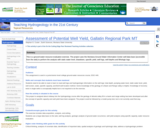
This project helps familiarize students with data commonly available from well drillers, the Department of Natural Resources and Conservation, and the Montana Bureau of Mines and Geology. Such data is often used to produce consulting reports. In this exercise, students practice working with available data and writing a consulting report while working on a real project of local interest. The question involves the probability of success in drilling a large well for a new county park. Students are given various maps and are guided through the use of a statewide database that contains well logs and well data. The outcome is a written report that describes the location and general geology of the site, uses the available data to summarize the types of materials that a driller might encounter, answers the questions that the client is interested in, and identifies problems or advantages presented by the groundwater system as indicated by available data.
(Note: this resource was added to OER Commons as part of a batch upload of over 2,200 records. If you notice an issue with the quality of the metadata, please let us know by using the 'report' button and we will flag it for consideration.)
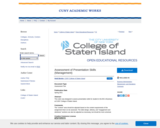
This rubric was designed to assess presentation skills for student in the BS in Business at CUNY College of Staten Island.
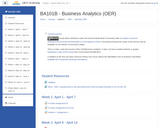
Second course in a two-course sequence. Introduces and applies technical skills around beginning and managing a small business, including spreadsheets and the use of charts and graphs. Includes reflection and discussion of the application of concepts to a real-world example. Requires teamwork and collaboration to be exercised in completing a group project. Covers application of financial, legal, and administrative procedures in running a business.
Upon successful completion of this course, students will be able to:
Represent business models in spreadsheets including preparation of charts and graphs. Apply key business activities and the primary concepts and terms associated with these activities. Manage a business interacting with the external environment (through a simulation) and describe how this interaction impacts both business and the external environment. Implement the financial, legal, and administrative procedures involved in starting new business ventures. Identify ethical issues facing businesses. Effectively collaborate with team members and communicate professionally.
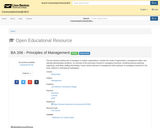
The key decision-making role of managers in modern organizations. Includes the study of organizations, management styles, and selected administrative problems. An overview of the processes involved in managing a business, including business planning, organizing, controlling, staffing and leading. Covers various theories of management with emphasis on managing a business in the local, national or international marketplace.
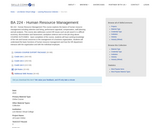
This course explores the basics of human resource management including selection and hiring, performance appraisal, compensation, staff planning and job analysis. This course also addresses current HR issues such as job search in a difficult economy, discrimination and harassment, workplace violence and on-the-job drug abuse.
Course Outcomes:
1. Upon completion of the course, students will have working knowledge of the role and human resources in the management of a business organization.
2. Students will understand the basic functions of human resource management and how the HR department interacts with the organization and with the individual employee.
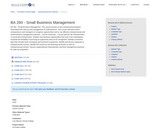
This course focuses on the entrepreneurial phases associated with start-up and management of small business. This course will teach future entrepreneurs and managers to recognize opportunities and to use effective entrepreneurial and small business management practices.
Course Outcomes:
1. List and discuss the characteristics of successful entrepreneurs.
2. Analyze new business opportunities that exist in the marketplace.
3. Evaluate the feasibility of pursuing an opportunity that you’ve recognized.
4. Develop a business plan that includes both conceptual and technical components.
5. Identify and discuss obstacles to entrepreneurial success.
6. Identify the resources and financing necessary to start an entrepreneurial venture.
7. Discuss organizational characteristics and best management practices for start-up companies.
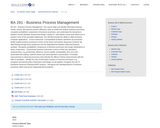
The course helps you identify information-bearing events, assess and improve process efficiency, learn to model and analyze business processes, recognize probabilistic components of business processes, and understand the interactions between human behavior and process design. Hands-on, case-based course work allows you to practice some of the principles addressed. You will demonstrate the ability to utilize business computer applications.
Course Outcomes:
Conceptualize business operations as processes.
1. Model simple business processes in terms of the actors and activity sequences involved, the data flowing through those sequences and the dependencies between data and business activities.
2. Recognize probabilistic components of business processes and assign distributions to these components.
3. Characterize business processes in terms of their key operations characteristics; e.g.,productivity, efficiency, service quality, sustainability, time and costs associated with waiting, material volume and service/product customization.
4. Formulate improvements to observed processes and estimate the effects of these improvements with the help of simulation.
5. Identify the role of information systems in business processes; e.g., recognize and specify where information technology can be applied; recognize the role of Enterprise Resource Planning (ERP) systems.
6. Recognize the interdependence of business processes within and across organizational boundaries.

This book is part of the college course BUS 104 Business Communication currently offered at Saddleback College in Mission Viejo, CA and taught by Dr. Scot Trodick. This book can be viewed along with original business communication content and activities which can be accessed by enrolling in BUS 104 Business Communication offered at Saddleback College in Mission Viejo, CA and taught by Dr. Scot Trodick. Material from this course is not included in this open educational resource. Enrolling in the course BUS 104 Business Communication at Saddleback College will provide full access to all materials and activities or the content can be obtained directly from Bishop Publishing.

This book is part of the college course BUS 105 Social Media Marketing currently offered at Saddleback College in Mission Viejo, CA and taught by Dr. Scot Trodick. This book can be viewed along with original social media marketing content which can be accessed by enrolling in BUS 105 Social Media Marketing offered at Saddleback College in Mission Viejo, CA and taught by Dr. Scot Trodick. Material from this course is not included in this open educational resource. Enrolling in the course BUS 105 Social Media Marketing at Saddleback College will provide full access to all materials or the content can be obtained directly from Bishop Publishing.

Here you can find web lectures discussing different aspects of health systems thinking.The first lecture is about the WHO health system building blocks, outlining this theoretical framework compromising of Leadership/Governance, Health workforce, Medical technologies, Financing, Information and Service delivery.The second lecture gives a historical background to the development and thinking aboiut health systems, outlining the different approaches over the past decades.The third lecture is on health financing and how this can be organised.The web lectures can be used seperately or as a package. You will also find pdf-files with the correponding powerpoint presentations
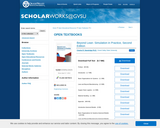
Lean thinking, as well as associated processes and tools, have involved into a ubiquitous perspective for improving systems particularly in the manufacturing arena. With application experience has come an understanding of the boundaries of lean capabilities and the benefits of getting beyond these boundaries to further improve performance. Discrete event simulation is recognized as one beyond-the-boundaries of lean technique. Thus, the fundamental goal of this text is to show how discrete event simulation can be used in addition to lean thinking to achieve greater benefits in system improvement than with lean alone. Realizing this goal requires learning the problems that simulation solves as well as the methods required to solve them. The problems that simulation solves are captured in a collection of case studies. These studies serve as metaphors for industrial problems that are commonly addressed using lean and simulation.
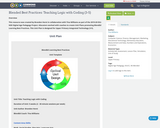
This resource was created by Brandon Horst in collaboration with Tina Williams as part of the 2019-20 ESU-NDE Digital Age Pedagogy Project. Educators worked with coaches to create Unit Plans promoting BlendEd Learning Best Practices. This Unit Plan is designed for Upper Primary Integrated Technology (3-5).
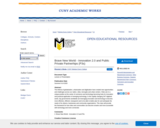
The trifecta of globalization, urbanization and digitization have created new opportunities and challenges across our nation, cities, boroughs and urban centers. Cities are in a unique position at the center of commerce and technology becoming hubs for innovation and practical application of emerging technology. In this rapidly changing 24/7 digitized world, city governments worldwide are leveraging innovation and technology to become more effective, efficient, transparent and to be able to better plan for and anticipate the needs of its citizens, businesses and community organizations. This class will provide the framework for how cities and communities can become smarter and more accessible with technology and more connected.
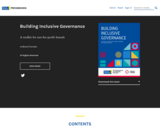
The goal of this toolkit is to give your board a way to measure your current state and to evaluate whether the actions you have taken to create a more diverse board are actually having a positive impact. In addition to supporting you to figure out your current state, it will provide you with resources to help you plan where you might go next. This practical toolkit is designed to help you understand the change process that organizations go through when they embark on the important, but at times demanding, journey to become more inclusive and respond to the needs of their board members, staff and the communities they serve.

Principles and foundations for the digital era
Short Description:
The book goes beyond the surface to explain why AECO digitization matters with respect to information. It presents information in the framework of representation, introduces a semantic typology of data and connects process to information management, towards a coherent and transparent theory of building information for the digital era.
Long Description:
Digitization in AECO is in a transitional phase. On one hand, technologies like BIM finally introduce symbolic representation and, on the other, there is an unhealthy and unproductive attachment to outdated, analogue practices and documents. The book goes beyond the surface to explain why digitization matters with respect to information. It presents information in the framework of representation, introduces a semantic typology of data and connects process to information management, towards a coherent and transparent theory of building information for the digital era.
Word Count: 56989
(Note: This resource's metadata has been created automatically by reformatting and/or combining the information that the author initially provided as part of a bulk import process.)

This course is an intensive one-week introduction to leadership, teams, and learning communities. The class meets daily for five days. The class serves as an introduction of concepts and uses a variety of experiential exercises to develop individual and team skills, as well as supportive relationships within the Leaders for Manufacturing class. As part of the focus on leadership, it discusses the idea of the "Universe Within", the images, thoughts, and experiences that are internal to all leaders.

This resource is a video abstract of a research paper created by Research Square on behalf of its authors. It provides a synopsis that's easy to understand, and can be used to introduce the topics it covers to students, researchers, and the general public. The video's transcript is also provided in full, with a portion provided below for preview:
"Strategic organizational learning is the heart of any productive activity – it’s the trending form of labor. A new article in Design Management Review illustrates how, over the long run, superior performance relies on superior learning. Specifically, knowledge assets embedded in routines, and effective organizational learning undergird dynamic capabilities, and these in turn help top performers to keep a competitive edge. Today, the leader’s new work is therefore to build knowledge-creative enterprises – enterprises that are extremely good at organizational learning and that buzz with positive energy and innovation. The five-stage consulting cycle for co-creating value (Discover-Design-Develop-Deliver-Decide Impact) presented in the article’s case study, can help. Ultimately, making an organization truly knowledge-creative can be done in many ways, but all of them require rigor resourcefulness, and a positive learning culture. Learn how your organization can learn too. Tkaczyk B. 2015..."
The rest of the transcript, along with a link to the research itself, is available on the resource itself.

Short Description:
This is an instructor guide for a seminar course, Business Agreements, which is offered to senior undergraduate business, MBA, and law students at the University of Windsor and combines senior students from both faculties for interdisciplinary study. Course design aims to promote learner engagement in experiential learning. Students engage with course content by analyzing real-world business contracts to produce short written submissions before class thereby preparing students for in-class discussions.This textbook was authored by Werner H. Keller and Nobuko Fujita (University of Windsor) and licensed under an Ontario Commons License (Version 1.0)
Long Description:
This is an instructor guide for a seminar course, Business Agreements, which is offered to senior undergraduate business, MBA, and law students at the University of Windsor and combines senior students from both faculties for interdisciplinary study. Course design aims to promote learner engagement in experiential learning. Students engage with course content by analyzing real-world business contracts to produce short written submissions before class thereby preparing students for in-class discussions.
This instructor guide is intended to support the wider use and reuse of the course content by educators in business, law, and related disciplines. Business agreements are case studies which create memorable, thought-provoking examples to help students develop skills and knowledge of the structure and content of typical business contracts. The instructor’s teaching philosophy focuses on lifelong learning and skill development. Thus, the course is designed to enable learners to meet the needs of a rapidly evolving labour market through experiential learning opportunities for upskilling and reskilling learners’ “literacy” with business agreements.
Word Count: 9564
(Note: This resource's metadata has been created automatically by reformatting and/or combining the information that the author initially provided as part of a bulk import process.)

Short Description:
This is an instructor guide for a seminar course, Business Agreements, which is offered to senior undergraduate business, MBA, and law students at the University of Windsor and combines senior students from both faculties for interdisciplinary study. Course design aims to promote learner engagement in experiential learning. Students engage with course content by analyzing real-world business contracts to produce short written submissions before class thereby preparing students for in-class discussions.This textbook was authored by Werner H. Keller and Nobuko Fujita (University of Windsor) and licensed under an Ontario Commons License (Version 1.0)
Long Description:
This is an instructor guide for a seminar course, Business Agreements, which is offered to senior undergraduate business, MBA, and law students at the University of Windsor and combines senior students from both faculties for interdisciplinary study. Course design aims to promote learner engagement in experiential learning. Students engage with course content by analyzing real-world business contracts to produce short written submissions before class thereby preparing students for in-class discussions.
This instructor guide is intended to support the wider use and reuse of the course content by educators in business, law, and related disciplines. Business agreements are case studies which create memorable, thought-provoking examples to help students develop skills and knowledge of the structure and content of typical business contracts. The instructor’s teaching philosophy focuses on lifelong learning and skill development. Thus, the course is designed to enable learners to meet the needs of a rapidly evolving labour market through experiential learning opportunities for upskilling and reskilling learners’ “literacy” with business agreements.
Word Count: 9476
(Note: This resource's metadata has been created automatically by reformatting and/or combining the information that the author initially provided as part of a bulk import process.)
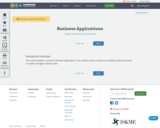
This is the complete course for Business Applications. The content consists of lectures, templates and instructions to create a stratgeic business plan.
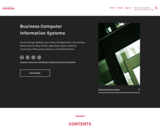
Word Count: 113331
(Note: This resource's metadata has been created automatically by reformatting and/or combining the information that the author initially provided as part of a bulk import process.)
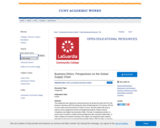
This assignment was inspired by a group discussion by faculty who teach the First Year Seminar in Business (BTF101) during the 2018-19 Rebooting the FYS Seminar. BTF101 is a two-credit course that meets for a total of 3 hours. We were tasked with ways to improve course assignments aimed at strengthening students‰Ûª Global Learning Competency and Digital Communication Ability. The topic of sweatshops abroad is a proven way to introduce a Global Learning assignment with a business related topic. In order to deepen the students‰Ûª learning on the subject, the assignment tasks students with taking on the role of a Corporate Responsibility Officer (CRO) for Nike. In choosing to put students in this role, they are required to think of multiple perspectives as required by the Global Learning rubric.
The assignment includes several phases and culminates in a student-made video. The first phase of the assignment has students explore sweatshops through video, class discussion and a short writing assignment. The research material provided is intentionally focused on Nike‰Ûªs sweatshops so that students can narrow their focus to a particular instance of sweatshop usage in order to more readily formulate a company-specific response in their roles as CRO for Nike. Once the research phase is complete, students are asked to make a video explaining the issue to Nike in the role of a CRO. The students have to think about Nike‰Ûªs role as a business, the ethical issues of sweatshops and the ways in which they can address the issues. Students work on the assignment during the last third of the semester, and the assignment takes approximately 2 or 3 class hours. To make it manageable, I created an ePortfolio assignment template since students are required to post part of it on ePortfolio. The assignment is used as a final in my classes and worth 20 % of the overall grade. I grade it according to the College‰Ûªs Competency rubric, which is discussed earlier in the semester to ensure that students are familiar with the rubric. Finally, there are a variety of ways to use the existing materials. While the assignment is meant to address the Global Learning Competency and Digital Communication Ability, it also offers opportunities to support the Oral and Written Communication Abilities.
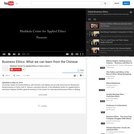
Confucian values of trustworthiness, self-criticism, and dignity can provide resources for Westerners doing business in China. Kirk O. Hanson, executive director of the Markkula Center for Applied Ethics, interviews Stephan Rothlin, general secretary of the Center for International Business Ethics in Beijing.
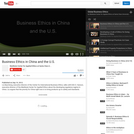
Liu Baocheng, executive director of the Center for International Business Ethics, talks with Kirk O. Hanson, executive director of the Markkula Center for Applied Ethics about the developing regulatory regime in China. Liu argues that the priority for China right now is to bring products up to safety and standards. They also discuss different cultural attitudes toward gifts and bribes.

Students in an introductory Management Information Systems (MIS) course often ask what a career in MIS looks like. Lacking a clear vision, they make their own assumptions. Often they assume the career involves programming with little human interaction. That MIS is a technical field could not be further from the truth. MIS job descriptions typically require candidates to be able to collaborate, communicate, analyze needs and gather requirements. They also list the need for excellent written and communication skills. In other words, MIS workers are constantly interacting with other people both inside and outside the organization. They are coming up with creative solutions to business problems.
This course is designed to help students get a feel for what a career in MIS would be like. Our students report that they learn more about information systems from their internships than from their IS courses. Consequently, we designed a course that looks very much like an internship—an introduction to the field followed by a substantial project.

This course explores successful approaches to delivering healthcare in challenging settings. We analyze organizations to find why some fall short while others grow in size and contribute to the health of the people they serve, and explore promising business models and social enterprise innovations.

Speaking & Presentation Skills for Business
Word Count: 11171
ISBN: 978-0-9879506-6-6
(Note: This resource's metadata has been created automatically by reformatting and/or combining the information that the author initially provided as part of a bulk import process.)
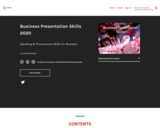
Speaking & Presentation Skills for Business
Word Count: 5495
(Note: This resource's metadata has been created automatically by reformatting and/or combining the information that the author initially provided as part of a bulk import process.)
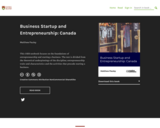
Short Description:
This OER textbook focuses on the foundations of entrepreneurship and starting a business. The text is divided from the theoretical underpinnings of the discipline; entrepreneurship traits and characteristics and the activities that precede starting a business.
Long Description:
Given the financial challenges students face in higher education, my hope with this textbook is to draw on my 20+ years of entrepreneurship experience and academic research to compile resources that reflect the general aspects of starting a business. Business Startup and Entrepreneurship: Canada is an Open Educational Resource (OER) textbook that focuses on the practical, current, and relevant topics associated with starting a business in Canada. This broad practical approach allows instructors to introduce these simple chapters to build a basic understating of the essentials to startups.
Along with this textbook is an accompanying Business Plan Workbook, helping students to work through a business idea chapter-by-chapter that hopefully culminates in a well thought-through startup plan. In my experience teaching introductory entrepreneurship courses, developing a business plan supports deep-level learning that is displayed through critical analysis, creativity, and networking. The design of the business plan has been simplified and tested over the past three years with over 750 students from diverse cultures and academic disciplines. It is my recommendation that students work on the business plan throughout the duration of the course as they complete chapters to reaffirm important lessons. Students may find tasks such as finance and accounting difficult, which is why an Excel Worksheet accompanies the business plan to help prepare financial reports for their proposed businesses.
Word Count: 115289
ISBN: 978-1-988692-57-9
(Note: This resource's metadata has been created automatically by reformatting and/or combining the information that the author initially provided as part of a bulk import process.)
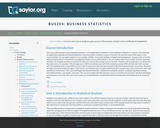
Introductory survey of quantitative methods (QM), or the application of statistics in the workplace. Examines techniques for gathering, analyzing, and interpreting data in any number of fieldsĺÎĺ from anthropology to hedge fund management.
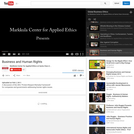
A discussion of the UN's "Protect-Respect-Remedy Framework" for companies and governments addressing human rights issues.

People in every corner of the world are innovating to solve social and environmental problems in their communities. In the past decade, new programs like MIT Solve have emerged to support those social entrepreneurs and drive partnerships to accelerate their impact. However, many startups find it difficult to develop business plans that clearly communicate their work and impact.
The main focus of this course is to help early-stage social impact startups define key aspects of their business by examining case studies from leading social entrepreneurs and both nonprofit and for-profit enterprises around the world.
The course was created by MIT Solve for MITx, and is now archived on the Open Learning Library (OLL), which is free to use. You have the option to sign up and enroll in each module if you want to track your progress, or you can view and use all the materials without enrolling.
This book is part of the college course CIMW 207 Social Media and Web Fundamentals currently offered at Saddleback College in Mission Viejo, CA and taught by Dr. Scot Trodick. This book can be viewed along with original social media and web fundamentals content which can be accessed by enrolling in CIMW 207 Social Media and Web Fundamentals offered at Saddleback College in Mission Viejo, CA and taught by Dr. Scot Trodick. Material from this course is not included in this open educational resource. Enrolling in the course CIMW 207 Social Media and Web Fundamentals at Saddleback College will provide full access to all materials or the content can be obtained directly from Bishop Publishing.

3. Brave New World - “CMR” Index and the U.S. Congressional Smart Cities Caucus
The trifecta of globalization, urbanization and digitization have created new opportunities and challenges across our nation, cities, boroughs and urban centers. Cities are in a unique position at the center of commerce and technology becoming hubs for innovation and practical application of emerging technology. In this rapidly changing 24/7 digitized world, city governments worldwide are leveraging innovation and technology to become more effective, efficient, transparent and to be able to better plan for and anticipate the needs of its citizens, businesses and community organizations. This class will provide the framework for how cities and communities can become smarter and more accessible with technology and more connected.

une présentation préliminaire d'une ressource pédagogique concernant la matière de Comptabilité des sociétés dans le contexte marocain. Dans cette ressource nous avons essayé de souligner :- les objectifs du projet en entier ainsi que les objectifs spécifiques d'apprentissage- la planification préliminaire du projet- une feuille de route du contenu de cour- une modalité d'évaluation ouverte et de son modélisation- un soulignemment des principales leçons tirées et des limites

This course focuses on the application of management theory and practices related to the planning, organizing, leading and controlling of Records Center.

This task was developed by high school and postsecondary mathematics and agriculture sciences educators, and validated by content experts in the Common Core State Standards in mathematics and the National Career Clusters Knowledge & Skills Statements. It was developed with the purpose of demonstrating how the Common Core and CTE Knowledge & Skills Statements can be integrated into classroom learning - and to provide classroom teachers with a truly authentic task for either mathematics or CTE courses.

This task was developed by high school and postsecondary mathematics and agriculture sciences educators, and validated by content experts in the Common Core State Standards in mathematics and the National Career Clusters Knowledge & Skills Statements. It was developed with the purpose of demonstrating how the Common Core and CTE Knowledge & Skills Statements can be integrated into classroom learning - and to provide classroom teachers with a truly authentic task for either mathematics or CTE courses.

Short Description:
Beginning your first career, or a new career is both exciting and challenging. This book will guide you along the journey towards a successful, fulfilling, and rewarding health or wellness office career.
Long Description:
This book is a road map to help you navigate the job search through practical and logical steps, including the following: Understand and practice professionalism Plan for your career Research today’s labour market Create robust self-marketing tools Build your personal brand Diversify your job search methods Utilize social media to create a professional digital footprint Master your interview skills to stand out from your competition
Word Count: 33297
(Note: This resource's metadata has been created automatically by reformatting and/or combining the information that the author initially provided as part of a bulk import process.)

Carrier systems involve the design, operation and management of transportation networks, assets, personnel, freight and passengers. In this course, we will present models and tools for analyzing, optimizing, planning, managing and controlling carrier systems.

Short Description:
CLEJHE is an open-access, double-blind peer-reviewed journal of case studies intended to aid in the preparation of leaders at all levels of higher education.
Long Description:
Cases on Leadership for Equity and Justice in Higher Education (CLEJHE) is an open-access, open education resource journal that publishes peer-reviewed cases for use by leadership preparation programs and those involved in developing leaders for post-secondary institutions. Through an equity lens, the journal strives to publish timely and highly relevant cases that involve and address significant puzzles of practice facing leaders at all levels in higher education. Cases provide narratives, exhibits, and teaching notes that seek to inform and offer suggestions to enhance the practice of the learners and leaders within our community of practice.
CLEJHE is a collaborative project at the University of Colorado Denver involving ThinqStudio and the School of Education and Human Development programs for Leadership for Educational Equity in Higher Education and Learning, Design, and Technology (LDT). The journal editors are doctoral students from the Leadership for Educational Equity in Higher Education program.
Word Count: 22241
(Note: This resource's metadata has been created automatically by reformatting and/or combining the information that the author initially provided as part of a bulk import process.)
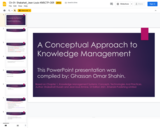
This is a first try of publishing OER through the Creative Common . This is a power point slide of chapter 1 of the book , Knowledge Management Systems: Concepts, Technologies And Practices. Author: Shabahati Husain and Jean-louis Ermine, !st Edition 2021, Emerald Publishing Limited.
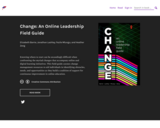
Knowing where to start can be exceedingly difficult when confronting the myriad changes that accompany online and digital learning initiatives. This field guide curates change management resources to aid individuals in identifying obstacles, needs, and opportunities as they build a coalition of support for continuous improvement in online education.

This course is a service-learning, project-based studio course that focuses on collaborative design of civic media. Students will work in diverse teams with community partners to create civic media projects grounded in real-world community needs. This course covers co-design and lean UX methods, and best practices for including communities in iterative stages of project ideation, design, prototyping, testing, launch, and stewardship. Students should have an interest in collaboration with community-based organizations.

Class slides for Sustainable Property Management (2023) are freely-available, screen-reader friendly, openly-licensed, and editable. The slides align with the freely-available open textbook, Sustainable Property Management, which is the required text for Virginia Tech's Department of Apparel, Housing, and Resource Management, PM 3674, Property Management Operations. The collection includes chapter-level .ppt slides with questions and activities for each of the eight chapters.
The open textbook, Sustainable Property Management, is freely available in PDF, ePub, Pressbooks, and other formats at https://doi.org/10.21061/sustainable_property_management.
Help us!
If you are an instructor reviewing, adopting, or adapting this textbook and/or slides, please help us understand your use by filling out this form https://bit.ly/interest_sustainable_property_management
How to adapt and share the slides
Instructors are encouraged to customize the slide deck by adding their own content and examples. According to the Creative Commons BY NC SA license, customized and shared versions of the slides must:
- Retain the original copyright statement
- Be released under the Creative Commons Attribution NonCommercial-ShareAlike (CC BY NC SA) 4.0 license
- Include a link to the original slide deck source: http://hdl.handle.net/10919/11342
- Include brief statement regarding whether or not changes were made
- List the name of the adapter

Classroom Management is cosidered one of the extremely important item in teaching. Teachers should have the ability to control their classes to achieve whatever they want.
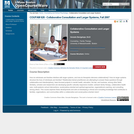
How do individuals and families interface with larger systems, and how do therapists intervene collaboratively? How do larger systems structure the lives of individuals and families? Relationally-trained practitioners are attempting to answer these questions through collaborative and interdisciplinary, team-focused projects in mental health, education, the law, and business, among other fields. Similarly, scholars and researchers are developing specific culturally responsive models: outreach family therapy, collaborative health care, multi-systemic school interventions, social-justice-oriented and spiritual approaches, organizational coaching, and consulting, among others. This course explores these developments and aims at developing a clinical and consulting knowledge that contributes to families, organizations, and communities within a collaborative and social-justice-oriented vision.

This course provides an introductory survey of data science tools in healthcare. It was created by members of MIT Critical Data, a global consortium consisting of healthcare practitioners, computer scientists, and engineers from academia, industry, and government, that seeks to place data and research at the front and center of healthcare operations.
The most daunting global health issues right now are the result of interconnected crises. In this course, we highlight the importance of a multidisciplinary approach to health data science. It is intended for front-line clinicians and public health practitioners, as well as computer scientists, engineers, and social scientists, whose goal is to understand health and disease better using digital data captured in the process of care.
What you'll learn:
Principles of data science as applied to health
Analysis of electronic health records
Artificial intelligence and machine learning in healthcare
This course is part of the Open Learning Library, which is free to use. You have the option to sign up and enroll in the course if you want to track your progress, or you can view and use all the materials without enrolling.
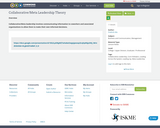
Collaborative/Meta leadership involves communicating information to coworkers and associated organizations to allow them to make their own informed decisions.

Communicating With Data has a distinctive structure and content, combining fundamental quantitative techniques of using data to make informed management decisions with illustrations of how real decision makers, even highly trained professionals, fall prey to errors and biases in their understanding. We present the fundamental concepts underlying the quantitative techniques as a way of thinking, not just a way of calculating, in order to enhance decision-making skills. Rather than survey all of the techniques of management science, we stress those fundamental concepts and tools that we believe are most important for the practical analysis of management decisions, presenting the material as much as possible in the context of realistic business situations from a variety of settings. Exercises and examples drawn from marketing, finance, operations management, strategy, and other management functions.

In this course, students develop and polish communication strategies and methods through discussion, examples, and practice with an emphasizes on writing and speaking skills necessary for effective leaders. The course includes several oral and written assignments which are integrated with other subjects, and with career development activities, when possible.
This course is part of the MBA core and is restricted to first-year Sloan graduate students. Find out more about the Sloan MBA core on OCW.
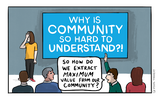
Community is key to open education, with an often-overlooked aspect of community management and evolution being how knowledge is stewarded within such networks. We from We Are Open in collaboration with participate are running a series of workshops called "Community Conversations" where we talk about different aspects of community management. This one is our fourth Community Conversations session and it was timed to coincide with Open Education Week, an initiative of OE Global.

This is a pathfinder designed for users who are new to Tableau Desktop and Tableau Public. The purpose of this pathfinder is to be a companion resource to the February 25, 2023 presentation Create Accurately and Interactive Dashboards with Tableau. The Tableau Student Ambassador presenters of the workshop were Taiwo Adegite, Junior Analyst; and Zena Patton, Corporate Learning Professional, and Librarian. To learn more about the Tableau Community Leader Ambassador program, go to the following link https://www.tableau.com/community/community-leaders/ambassadors This companion resource is an artifact of a global, collaborative effort between Taiwo Adegite (Nigeria), Junior Analyst; and Zena Patton (United States of America), Corporate Learning Professional, and Librarian.Last update April 15, 2023. This update includes resources from Flip the Tableau! Learning Experience.

This course aims to develop negotiation skills by active participation in a variety of negotiation settings, and a series of integrative bargaining cases between two and more than two parties over multiple issues. Ethical dilemmas in negotiation are discussed at various times throughout the course.
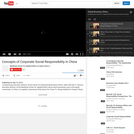
Liu Baocheng, executive director of the Center for International Business Ethics, talks with Kirk O. Hanson, executive director of the Markkula Center for Applied Ethics, about what businesses owe to the larger community. In China, Liu explains, businesses think about the Three P's: Responsibility for People, Planet, and Profit.

Perspectives for the Canadian Workplace
Short Description:
This book examines the nature of conflict in the workplace - its sources, costs and management, as well as workplace conflict management with respect to group interactions, organizational culture, and provincial/federal legislation. In addition, this book focuses on the individual; how our perceptions, emotions, motivation, personality and communication skills impact how we manage stress and conflict at work. Throughout the book, readers are encouraged to engage in critical self-assessment and case study review. These exercises provide the reader with the opportunity to assess potential conflict situations, recognize emotions, communicate assertively, and manage conflict with integrity and professionalism.
Long Description:
This Open Educational Resource (OER) is a custom publication for students enrolled in PSYC-6006: Conflict Management.
In the first half of the book, we will examine the nature of conflict in the workplace – its sources, costs and management. We will also briefly examine workplace conflict management with respect to group interactions, organizational culture, and provincial/federal legislation.
During the second half of the book, the focus will be on the individual; how our perceptions, emotions, motivation, personality and communication skills impact how we manage stress and conflict at work.
Throughout the book, you will be encouraged to engage in critical self-assessment and case studies. These exercises will provide you with the opportunity to assess potential conflict situations, recognize your emotions, communicate assertively, and manage conflict with integrity and professionalism.
Word Count: 168804
(Note: This resource's metadata has been created automatically by reformatting and/or combining the information that the author initially provided as part of a bulk import process.)

This course analyzes the development of the United States Congress by focusing on the competing theoretical lenses through which legislatures have been studied. In particular, it compares sociological and economic models of legislative behavior, applying those models to floor decision-making, committee behavior, political parties, relations with other branches of the Federal government, and elections. Graduate students are expected to pursue the subject in greater depth through reading and individual research.
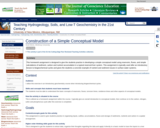
This homework assignment is designed to give the students practice in developing a simple conceptual model using reservoirs, fluxes, and simple calculations of sediment, carbon and nutrient accumulation in a typical reservoir/river system. This assignment is typically used after an introductory lecture to biogeochemical cycles and gives the students a concrete example of nutrient and sediment issues in surface water systems.
(Note: this resource was added to OER Commons as part of a batch upload of over 2,200 records. If you notice an issue with the quality of the metadata, please let us know by using the 'report' button and we will flag it for consideration.)

This course provides a solid understanding of consumer decision-making and how new products and services are developed, especially given the rapid pace of innovation and regulatory change, to help students succeed in consumer finance today. Specific examples will be drawn from retirement saving products, credit cards, peer to peer lending, cryptocurrencies, and financial advising.
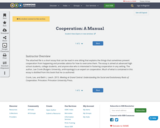
The attached file is a short essay that can be read in one sitting that explains the things that sometimes prevent cooperation from happening and provides advice for how to overcome them. The essay is aimed at advanced high school students, college students, and anyone else who is interested in fostering cooperation in any setting. The author, Lee Cronk (Rutgers University, anthropology) is an expert on cooperation. Much of what is contained in this essay is distilled from this book that he co-authored:Cronk, Lee, and Beth L. Leech. 2013. Meeting at Grand Central: Understanding the Social and Evolutionary Roots of Cooperation. Princeton: Princeton University Press.
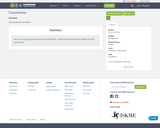
Introduction of Correlation
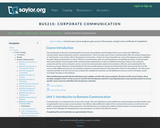
The introduction of Business Communication for Success, the textbook used throughout this course, notes that Ň[E]ffective communication takes preparation, practice, and persistence. There are many ways to learn communication skills; the school of experience, or Ôhard knocks,Ő is one of them. But in the business environment, a ÔknockŐ (or lesson learned) may come at the expense of your credibility through a blown presentation to a client.Ó Effective communication skills are a prerequisite for succeeding in business. Communication tools and activities connect people within and beyond the organization in order to establish the businessŐs place in the corporate community and the social community, and as a result, that communication needs to be consistent, effective, and customized for the business to prosper. Business Communication for Success provides theories and practical information that represent the heart of this course, while additional resources are included to expand or pose alternatives to the approaches chosen in the textbook. You will receive maximum benefits from this course if you complete the readings first and then use the additional resources to fill in the blanks and/or reconsider the topics in the textbook.
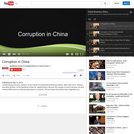
Liu Baocheng, executive director of the Center for International Business Ethics, talks with Kirk O. Hanson, executive director of the Markkula Center for Applied Ethics, to discuss the Foreign Corrupt Practices Act and cultural differences in understanding about corruption. Gift exchange has always been regarded as a virtue in China, but the two distinguish between gift giving and quid pro quo corruption.
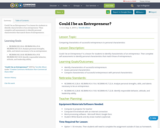
Could I be an Entrepreneur? Is a lesson for students to identify characterisitcs of an entrepreneur. Then complete self assessments to identify personal characteristics that match those of entrepreneurs.

A course module focused on Managerial Decision-Making with learning objectives, readings and resources, an application activity related to emotional intelligence, and a discussion prompt and questions related to the material.

Continuous Improvement in Action
Short Description:
This is a multimedia-enabled case in which students will be guided, by an industry expert, to apply structured problem-solving that addresses a typical supply chain problem, missing parts. What first appears as the issue may be a symptom of a root cause(s). The case utilizes videos, data files for analytics, audio recording, and videogame-style exercises to find the missing box of parts. The case is a collaboration between the Conestoga Centre for Supply Chain Innovation and ATS Automation and utilizes the ATS Business Model (ABM) approach to identifying and solving root causes. The case can be used in any Continuous Improvement course or program for either Business or Engineering students.
Long Description:
This is a multimedia-enabled case in which students will be guided, by an industry expert, to apply structured problem-solving that addresses a typical supply chain problem, missing parts. What first appears as the issue may be a symptom of a root cause(s). The case utilizes videos, data files for analytics, audio recording, and videogame-style exercises to find the missing box of parts. The case is a collaboration between the Conestoga Centre for Supply Chain Innovation and ATS Automation and utilizes the ATS Business Model (ABM) approach to identifying and solving root causes. The case can be used in any Continuous Improvement course or program for either Business or Engineering students.
Word Count: 5680
(Note: This resource's metadata has been created automatically by reformatting and/or combining the information that the author initially provided as part of a bulk import process.)

This course introduces managers and other professionals working in the nonprofit sector to Value Based Management. The course attempts to establish a common framework for how nonprofit's and non-governmental organizations can apply Value Based Management in such areas as Strategic Planning, Resource Development, Leadership, and Performance Measurement. Course Level: Intermediate - A good understanding of business concepts is useful for fully understanding this course. A review of other Short Courses is also recommended since this course covers topics that may be covered in greater deal in another short course. Recommended for 2.0 hours of CPE. Course Method: Inter-active self study with audio clips, self-grading exam, and certificate of completion.

This is a short description of the differences in business between cost and price, as well as consumer and business customer. These terms are often confused.
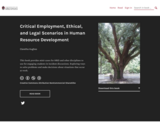
Short Description:
This book provides mini-cases for HRD and other disciplines to use for engaging students in incident discussions. Exploring ways to solve problems and make decisions about situations that occur at work.
Long Description:
This book is intended to be used as a supplement to courses across various fields of study but has direct correlations with human resource development and workforce development. Instructors in any field of study where students examine the work environment and the treatment of employees will find useful scenarios that can be used to facilitate discussions. The topics in this book and supplemental readings can enrich the conversations around enhancing workplace environments and better worker engagement. Without supportive workers, organizations cannot achieve all goals to the extent desired. Workers may exert the effort required to keep their jobs, but they may not exceed performance requirements because they are experiencing scenarios similar to those in this book and their needs are not being met appropriately.
Leaders and workplace trainers may find this supplement useful when introducing subjects that are perceived to be controversial in the workplace. They can allow employees to discuss these scenarios and provide possible solutions to similar scenarios that are encountered at work. Providing a safe environment to discuss intentional and unintentional situations that arise may improve the work climate and lead to unimaginable solutions. Strengthening communication between workers and leaders can improve team performance and ultimately, organizational success.
Word Count: 12056
(Note: This resource's metadata has been created automatically by reformatting and/or combining the information that the author initially provided as part of a bulk import process.)
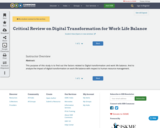
Abstract:This purpose of this study is to find out the factors related to Digital transformation and work life balance. And to analyze the impact of digital transformation on work life balance with respect to human resource management.

Cross Cultural Leadership is a collaborative research seminar that examines what constitutes "effective" leadership across cultures. It is collaborative because the students are expected to provide some of the content. The weekly readings target particular aspects of cultural differentiation. Working within those topics, students are asked to describe aspects of leadership in particular cultures based on their research and/or personal experiences. The goal of the course is to help prepare students for business assignments outside of their native countries.
Course deliverables include: active participation in the class, contribution of class content on a weekly basis and an end of course paper that explores some aspect of leadership across cultures.
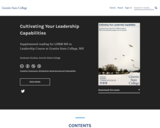
Supplemental reading for LD820 MS in Leadership Course at Granite State College, NH
Word Count: 50854
(Note: This resource's metadata has been created automatically by reformatting and/or combining the information that the author initially provided as part of a bulk import process.)

Short Description:
Customer centricity is about organizational transformation making the customer the focus for business decisions, processes, product development, services, and procedures. Some companies purport to be customer centric but they fall short in connecting this concept throughout all functional areas of the business. While it is important to offer superb customer service, being customer centric is far more than that. It's about mapping the customer journey to discover customer needs and wants, what's working and what is not, then taking action to improve the customer experience. Customer loyalty is built through providing exceptional customer experiences. This in turn increases revenues through positive company image, referrals, and increased customer lifetime value. Most organizations today realize that they must focus on the customer to remain competitive.
Word Count: 44793
(Note: This resource's metadata has been created automatically by reformatting and/or combining the information that the author initially provided as part of a bulk import process.)
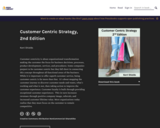
Customer centricity is about organizational transformation making the customer the focus for business decisions, processes, product development, services, and procedures. Some companies purport to be customer centric but they fall short in connecting this concept throughout all functional areas of the business. While it is important to offer superb customer service, being customer centric is far more than that. It's about mapping the customer journey to discover customer needs and wants, what's working and what is not, then taking action to improve the customer experience. Customer loyalty is built through providing exceptional customer experiences. This in turn increases revenues through positive company image, referrals, and increased customer lifetime value. Most organizations today realize that they must focus on the customer to remain competitive.

Autumn 2022 Edition
Short Description:
This textbook is based on materials sourced from different practitioners from the world of research design, data collection, analysis, and interpretation. The author and her collaborators have also added materials to supplement the available literature. This activity is aligned with SDG4 – Quality Education and SDG10 - Reduced Inequalities. NewParaThis first edition is running concurrently with Customer Insights. Second Edition.
Long Description:
Increasingly, the concept of marketing research is being replaced with the term ‘customer or consumer insights’. As decision-makers are bombarded with data, it is important to have an Insights Team or Department which can sift through it all and identify those nuggets of information that can meaningfully explain human behaviour. Such insights must translate into an informed business strategy for success. This book has been curated to ensure that the practice of data collection, analysis, and interpretation is presented from an industry perspective. This first edition is running concurrently with Customer Insights. Second Edition https://oercollective.caul.edu.au/customer-insights/
Word Count: 41271
(Note: This resource's metadata has been created automatically by reformatting and/or combining the information that the author initially provided as part of a bulk import process.)

Second Edition
Short Description:
This textbook is based on materials sourced from different practitioners from the world of research design, data collection, analysis, and interpretation. The author and her collaborators have also added materials to supplement the available literature.
Long Description:
Increasingly, the concept of marketing research is being replaced with the term ‘customer or consumer insights’. As decision-makers are bombarded with data, it is important to have an Insights Team or Department which can sift through it all and identify those nuggets of information that can meaningfully explain human behaviour. Such insights must translate into an informed business strategy for success. This book has been curated to ensure that the practice of data collection, analysis, and interpretation is presented from an industry perspective.
Word Count: 42069
(Note: This resource's metadata has been created automatically by reformatting and/or combining the information that the author initially provided as part of a bulk import process.)

Word Count: 78353
Included H5P activities: 42
(Note: This resource's metadata has been created automatically by reformatting and/or combining the information that the author initially provided as part of a bulk import process.)

This course introduces concepts of supply chain design and operations with a focus on supply chains for products destined to improve quality of life in developing countries. Topics include demand estimation, capacity planning and process analysis, inventory management, and supply chain coordination and performance. We also cover issues specific to emerging markets, such as sustainable supply chains, how to couple product design with supply chain design and operation, and how to account for the value-adding role of a supply chain. A major aspect of class is the student projects on supply chain design or improvement.
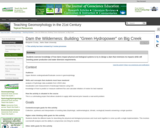
Student must synthesize the data that go into the construction and operation of a large hydroelectric dam. Students must strive to develop a design that minimizes or mitigates the impacts of the dam on the existing watershed. Students divide the analysis and frequently present to each other their findings. These findings are then synthesized into independent reports produced by each student.
Designed for a geomorphology course
Uses online and/or real-time data
Uses geomorphology to solve problems in other fields
Addresses student misconceptions
(Note: this resource was added to OER Commons as part of a batch upload of over 2,200 records. If you notice an issue with the quality of the metadata, please let us know by using the 'report' button and we will flag it for consideration.)

Short Description:
Data analytics is a rapidly evolving field. In today's labour market, knowing how to acquire, process, and interpret large amounts of data to make optimal decisions is crucial for many professionals, especially those in business and engineering. This open textbook, "a new online course" if you will, focuses on three key concept areas: data acquisition, data processing, and decision-making models. In this course, students will be able to develop advanced knowledge and skills to acquire related data for operations of business or projects; apply quantitative literacy skills such as statistics and machine learning; and use predictive or prescriptive modeling to make timely, actionable, and meaningful decisions.
Long Description:
Data analytics is a rapidly evolving field. In today’s labour market, knowing how to acquire, process, and interpret large amounts of data to make optimal decisions is crucial for many professionals, especially those in business and engineering. This open textbook, “a new online course” if you will, focuses on three key concept areas: data acquisition, data processing, and decision-making models. In this course, students will be able to develop advanced knowledge and skills to acquire related data for operations of business or projects; apply quantitative literacy skills such as statistics and machine learning; and use predictive or prescriptive modeling to make timely, actionable, and meaningful decisions.
Word Count: 2054
(Note: This resource's metadata has been created automatically by reformatting and/or combining the information that the author initially provided as part of a bulk import process.)

Short Description:
Data analytics is a rapidly evolving field. In today's labour market, knowing how to acquire, process, and interpret large amounts of data to make optimal decisions is crucial for many professionals, especially those in business and engineering. This open textbook, "a new online course" if you will, focuses on three key concept areas: data acquisition, data processing, and decision-making models. In this course, students will be able to develop advanced knowledge and skills to acquire related data for operations of business or projects; apply quantitative literacy skills such as statistics and machine learning; and use predictive or prescriptive modeling to make timely, actionable, and meaningful decisions.
Long Description:
Data analytics is a rapidly evolving field. In today’s labour market, knowing how to acquire, process, and interpret large amounts of data to make optimal decisions is crucial for many professionals, especially those in business and engineering. This open textbook, “a new online course” if you will, focuses on three key concept areas: data acquisition, data processing, and decision-making models. In this course, students will be able to develop advanced knowledge and skills to acquire related data for operations of business or projects; apply quantitative literacy skills such as statistics and machine learning; and use predictive or prescriptive modeling to make timely, actionable, and meaningful decisions.
Word Count: 2038
(Note: This resource's metadata has been created automatically by reformatting and/or combining the information that the author initially provided as part of a bulk import process.)

Data that has relevance for managerial decisions is accumulating at an incredible rate due to a host of technological advances. Electronic data capture has become inexpensive and ubiquitous as a by-product of innovations such as the internet, e-commerce, electronic banking, point-of-sale devices, bar-code readers, and intelligent machines. Such data is often stored in data warehouses and data marts specifically intended for management decision support. Data mining is a rapidly growing field that is concerned with developing techniques to assist managers to make intelligent use of these repositories. A number of successful applications have been reported in areas such as credit rating, fraud detection, database marketing, customer relationship management, and stock market investments. The field of data mining has evolved from the disciplines of statistics and artificial intelligence.
This course will examine methods that have emerged from both fields and proven to be of value in recognizing patterns and making predictions from an applications perspective. We will survey applications and provide an opportunity for hands-on experimentation with algorithms for data mining using easy-to-use software and cases.